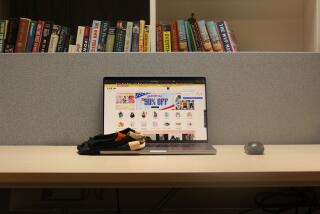Can you go a year without buying frippery? She did
ON a crowded New York City subway car, the day after Thanksgiving, sitting between “two members of a wet, overstuffed, and ketchup-smelling family of Christmas shoppers,” author Judith Levine gets an idea: “What if I (along with my live-in partner, Paul) undertook an X-treme trial of non-consumption, a Buy Nothing Year?”
Levine (a Brooklyn- and Vermont-based writer who a few years ago earned some notoriety and a Los Angeles Times Book Prize by arguing that “sexual expression is a healthy and happy part of growing up” in “Harmful to Minors: The Perils of Protecting Children From Sex”) tells us that she has maxed out her credit cards. She is alarmed by the social, environmental and economic costs of America’s love affair with shopping. She wonders, “[C]an a person have a social, community, or family life, a business, a connection to the culture, an identity, even a self outside the realm of purchased things and experiences?”
And so, a great experiment is born: “Starting January 1, 2004, Paul and I will purchase only necessities for sustenance, health, and business.”
Ah, but what counts as “only necessities”? A daily copy of the New York Times (even in Vermont)? Necessity. But eating out, paying for entertainment and even Q-tips? Verboten. In May, when the “final shard of Body Time rosemary-mint aromatherapy soap slides down the drain,” Levine glumly announces: “Now we’ll make do with Ivory.”
As she goes through the year with her purse tied behind her back, she finds she is left out. (The pair let their friends in on the project and do not let themselves take handouts.) They find that social life, especially in New York City, revolves around going out -- to meals, movies and other merriments that do not count as necessities. Without her usual fix of modern distraction, she admits feeling “bored ... lonely, antsy.”
She wonders: Is shopping really so bad? Is anti-consumerism merely, as a colleague puts it, “the Puritanism of the left?” Advertisers are up to no good, in Levine’s eyes, for assaulting us with our inadequacies and fears so we will buy more, but “I don’t want to tell the girls in the store that it’s wrong to want those frivolous shoes, because I don’t want to risk suggesting they give up the sexy dream of dancing the night away.”
Levine seeks out others who are trying to consume less. In Brooklyn, she links up with the Voluntary Simplicity movement and its promise of “frugal consumption, ecological awareness, and personal growth.” She finds a ragtag bunch trying to get their personal lives in order, obsessing over “clutter.” She wonders whether “cutting back my personal consumption will do any more than make me feel better.” She also joins the Take Back Your Time movement, which advocates for a work-less, spend-less economy. Shortly after joining, she gets the following e-mail from the group’s organizer: “Our planned event for TAKE BACK YOUR TIME has been canceled so that you can Take Back Your Time.” Upon further inquiry, Levine learns that she was the only member of the group who actually had time to attend.
It is only in Vermont that Levine finds a few people who are truly “off the grid.” There is Richard Czaplinski, who lives in a solar-powered cabin and bought his last pair of shoes, for a quarter, 15 years before. Czaplinski calls his radically simple existence “nirvana.” But such self-sufficiency is also a full-time job.
At the end of the year, Levine has saved $8,000, enough to pay off her credit cards and has learned that “where getting and having are concerned, enough is significantly less than we, and Americans generally, think it is.” Well, surprise! She seems chastened by the experience, glad to have gotten in touch with what Paul calls “embracing the ordinary.” But she also needs socks.
What makes “Not Buying It” stand out among the many books about consumerism is the personal approach. By following Levine’s progress, the reader gets to appreciate the difficult trade-offs and tensions in not consuming. Her entertaining prose also does a good job of integrating a number of important academic works on the subject, making them relevant and digestible. The academic works, in turn, lend Levine’s story some thought puzzles.
The trade-off to the personal, however, is a certain myopia. At one point, Levine offhandedly shares that she has heard a story on NPR that one-quarter of America’s working families are living in poverty. But she quickly moves on to the next subject, never stopping to think about the relationship between America’s consumerist mentality (low, low prices!) and its alarming poverty (low, low wages!). Similarly, there are occasional worries that rampant consumerism might be destroying the environment. But recycling is difficult and expensive, she complains, and “saving the earth is something of a bourgeois consumer privilege, too.”
No doubt, Levine really does care about these bigger issues. Yet by focusing primarily on the personal choices and consequences of not shopping, Levine may be telling us far more about the mind-set of American consumerism than perhaps she even fully realizes.
*
Lee Drutman is co-author of “The People’s Business: Controlling Corporations and Restoring Democracy.”
More to Read
Sign up for our Book Club newsletter
Get the latest news, events and more from the Los Angeles Times Book Club, and help us get L.A. reading and talking.
You may occasionally receive promotional content from the Los Angeles Times.






